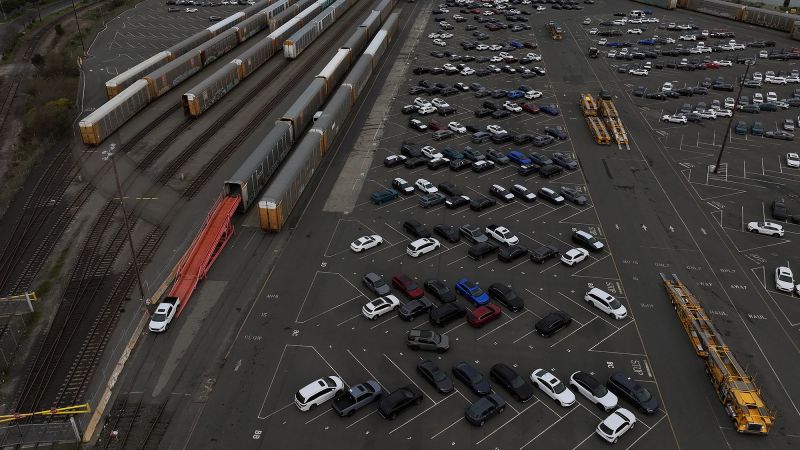New York
President Donald Trump is set to announce at 4 pm ET Wednesday tariffs on cars shipped to the United States, White House press secretary Karoline Leavitt told reporters.
Trump previously said he would announce auto tariffs on April 2, the day he’s expected to announce a package of reciprocal tariffs. However, earlier this week, he hinted at an earlier rollout for the auto sector.
Leavitt did not immediately share any details on the tariffs, including the rate and date they will go into effect, saying Trump will deliver that information later in the day.
This comes after the Big Three US automakers, Stellantis, Ford and General Motors, successfully lobbied for exemptions to 25% tariffs on all goods coming to the US from Canada and Mexico that were set to go into effect earlier this month.
The exemption Trump announced allowed for autos to come in duty-free if they were compliant with the terms of the United States-Mexico-Canada Agreement (USMCA) free trade agreement. Trump later applied that to all goods coming from the two countries. However, that’s set to expire on April 2, when Trump could announce higher tariff rates for the two countries and many others as part of his “Liberation Day.”
“I gave the American car companies a break because it would have been unfair if I didn’t,” Trump said last week.
The move caught the auto industry by surprise once again. An executive at one of the automakers, who spoke on background to Wednesday, said they had been working with the assumption that none of the auto tariffs would take effect for another week.
“We were all kind of expecting April 2 to be our day,” said the auto executive. “But if the Trump administration has shown us anything, I mean, things are unexpected.”
The tariffs could quickly raise the prices of new cars by thousands of dollars, according to industry experts. There is no such thing as an all-American car, since all depend on parts from Mexico and Canada for a significant part of their content. According to analysis by Michigan-based think tank Anderson Economic Group, the cost of producing vehicles built at US plants will rise by between $3,500 to $12,000 each.
The US government tracks what percentage of each car’s parts is made “domestically.” But under current trade law, Canadian-made parts and US-made parts are all counted as the same domestic content. Even with the broader definition of “American made,” none exceed 75%.
The North American car industry has operated for decades as if the continent is one giant country, thanks to free trade agreements signed by presidents from Bill Clinton to Trump himself. Parts and whole vehicles have flowed freely across borders, sometimes multiple times, before they end up in an American dealership.
There are only two vehicles that are considered to be 75% American-made by the US government the Tesla Model 3, and the Honda Ridgeline, a pickup assembled at a Honda plant in Lincoln, Alabama. And once again, that 75% includes any content that currently comes from Canada, and could be subject to new tariffs.
Almost all of the vehicles that have 50% or more of their content from US or Canadian suppliers are either built by Tesla or brands that are ostensibly “foreign,” but actually assemble cars in the US Honda, Hyundai, Kia, Nissan, Mazda, Subaru and Toyota.
The Ford F-150, the most popular vehicle in the United States for more than 40 years, has the most domestic content of any vehicle made by one of the traditional “Big Three” automakers. While all the parts are assembled into a pickup truck in either Michigan or Missouri, only 45% of those parts come from US or Canadian factories. Many of the larger versions of its engines come from Mexico.
“Yes, it’s America’s truck, assembled in America, but not with American parts,” Ivan Drury, director of insights for Edmunds, told recently.
Even if tariffs only apply to fully assembled vehicles and not auto parts, it is likely to raise average car prices by eliminating some lower-cost options for car buyers. Some Mexican-assembled vehicles, like the Chevrolet Blazer or Honda HR-V could be priced out of the market, and automakers might decide to stop offering them altogether rather than build them at US factories. Cars built in Mexico are most often lower-priced, lower-profit models that are only able to maintain their profitability by being built with cheaper Mexican labor.
“One of the losses from tariffs tends to be a loss of product variety,” said another auto industry executive who spoke to Wednesday.
It’s not only the smaller, entry-level models built in Mexico that could see price hikes. Trump’s auto tariffs could impact many models that car buyers don’t realize are imports, such as the heavy duty versions of Ram pickup trucks, which are built in a Stellantis plant in Saltillo, Mexico. Some versions of the Chevrolet Silverado are also built in Mexico. Even if the automakers shift production of those more profitable vehicles back from Mexico to US factories, it would take years to accomplish the switch.


